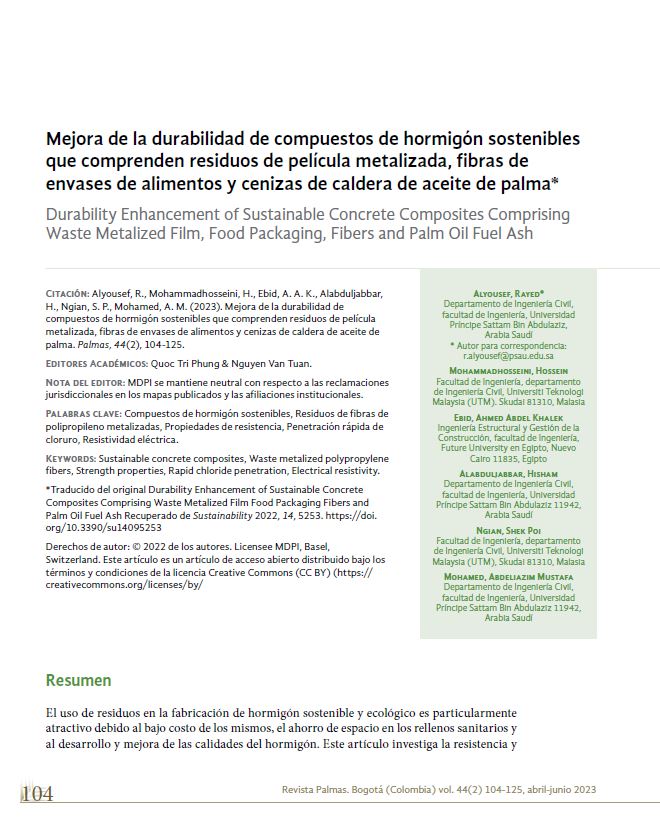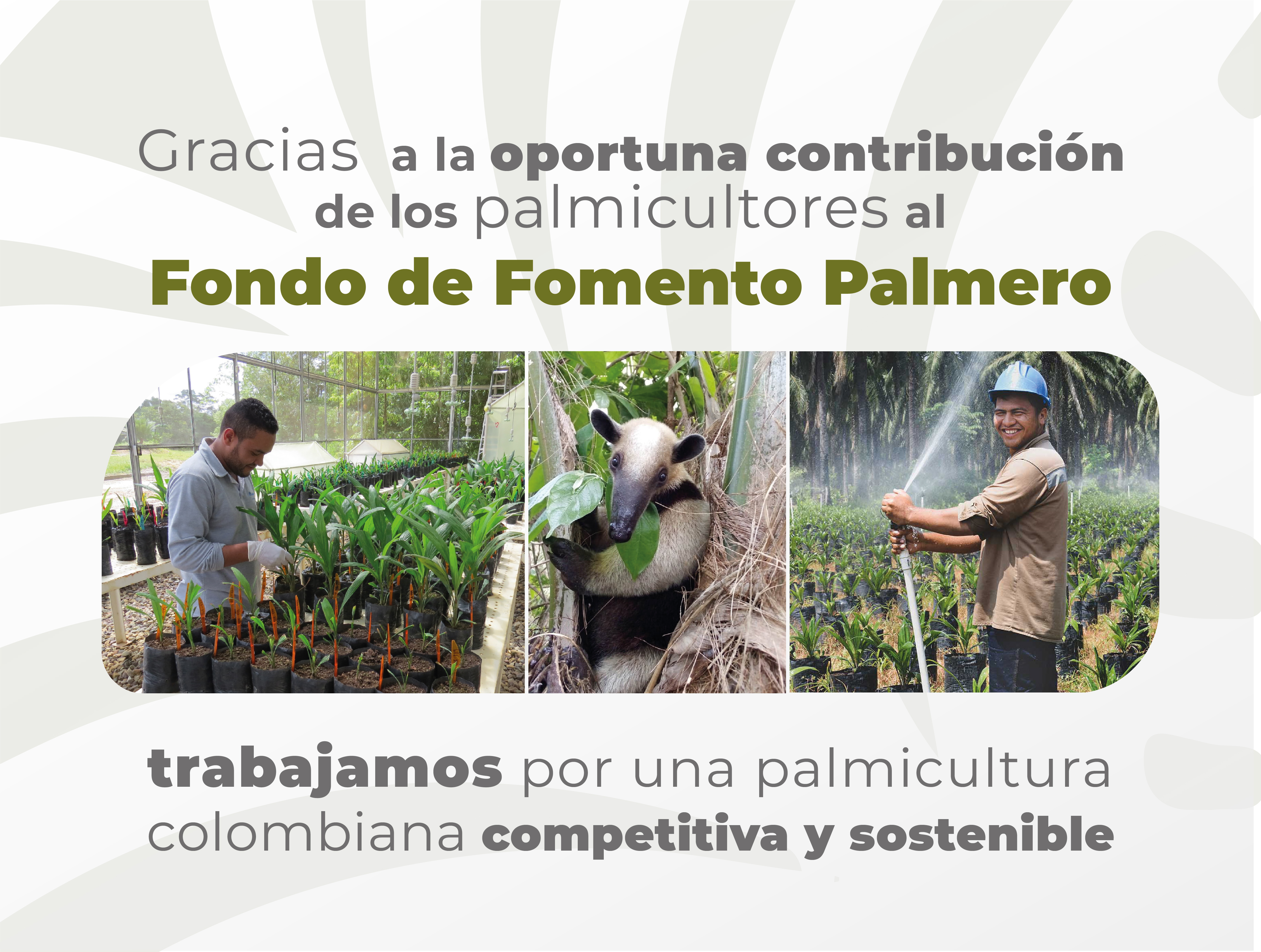Mejora de la durabilidad de compuestos de hormigón sostenibles que comprenden residuos de película metalizada, fibras de envases de alimentos y cenizas de caldera de aceite de palma
Palabras clave:
compuestos de hormigón sostenibles, penetración rápida de cloruro, propiedades de resistencia, residuos de fibras de polipropileno metalizados, resistividad eléctrica.Resumen
El uso de residuos en la fabricación de hormigón sostenible y ecológico es particularmente atractivo debido al bajo costo de los residuos, al ahorro de espacio en los rellenos sanitarios y al desarrollo y mejora de las calidades del hormigón. Este artículo investiga la resistencia y la durabilidad de los compuestos de hormigón ecológico hechos de fibras de envases de alimentos de lámina metalizada (MFP, por sus siglas en inglés) y ceniza de caldera de aceite de palma (POFA, por sus siglas en inglés). Las propiedades exploradas incluyen las resistencias a la compresión y la tensión, la carbonatación, la contracción por secado, la resistividad eléctrica y las pruebas rápidas de penetración de cloruro en mezclas de hormigón. Con cemento Portland ordinario (CPO), se emplearon fibras MFP de 20 mm de longitud y fracciones de 6 volúmenes que variaban de 0 a 1,25 %. Se hicieron otras 6 mezclas de hormigón con 20 % de POFA en lugar de CPO. Los resultados mostraron que la adición de fibras MFP a las mezclas de hormigón reducía su resistencia a la compresión. Y a pesar de tener una reducción menor en la resistencia a la compresión, la inclusión de fibras MFP aumentó significativamente la resistencia a la tracción. Los hallazgos muestran que la combinación de fibras de MFP con POFA afecta sustancialmente la durabilidad del hormigón. La adición de fibras MFP a las mezclas de hormigón dio como resultado una reducción de la carbonatación y la contracción por secado. También se redujo la penetración de cloruros en las muestras mientras que la resistividad eléctrica de las muestras reforzadas aumentó casi un 80 % en comparación con el hormigón ordinario.
Referencias bibliográficas
Sun, C.; Chen, Q.; Xiao, J.; Liu, W. Utilization of waste concrete recycling materials in self-compacting concrete. Resour. Conserv. Recycl. 2020, 161, 104930. [CrossRef]
Choudhary, J.; Kumar, B.; Gupta, A. Feasible utilization of waste limestone sludge as filler in bituminous concrete. Constr. Build. Mater. 2020, 239, 117781. [CrossRef]
Mohammadhosseini, H.; Yatim, J. M.; Sam, A. R. M.; Awal, A. A. Durability performance of green concrete composites containing waste carpet fibers and palm oil fuel ash. J. Clean. Prod. 2017, 144, 448-458. [CrossRef]
Siddique, R.; Singh, G. Utilization of waste foundry sand (WFS) in concrete manufacturing. Resour. Conserv. Recycl. 2011, 55, 885-892. [CrossRef]
Alaskar, A.; Alqarni, A. S.; Alfalah, G.; El-Sayed, A. K.; Mohammadhosseini, H.; Alyousef, R. Performance evaluation of reinforced concrete beams with corroded web reinforcement: Experimental and theoretical study. J. Build. Eng. 2021, 35, 102038. [CrossRef]
Mohammadhosseini, H.; Alyousef, R.; Poi Ngian, S.; Tahir, M. M. Performance evaluation of sustainable concrete comprising waste polypropylene food tray fibers and palm oil fuel ash exposed to sulfate and acid attacks. Crystals 2021, 11, 966. [CrossRef]
Gu, L.; Ozbakkaloglu, T. Use of recycled plastics in concrete: A critical review. Waste Manag. 2016, 51, 19-42. [CrossRef]
Sharma, R.; Bansal, P.P. Use of different forms of waste plastic in concrete-A review. J. Clean. Prod. 2016, 112, 473-482. [CrossRef]
Saikia, N.; de Brito, J. Use of plastic waste as aggregate in cement mortar and concrete preparation: A review. Constr. Build. Mater. 2012, 34, 385-401. [CrossRef]
Albano, C.; Camacho, N.; Hernández, M.; Matheus, A.; Gutiérrez, A. Influence of content and particle size of waste pet bottles on concrete behavior at different w/c ratios. Waste Manag. 2009, 29, 2707-2716. [CrossRef]
Eriksen, M.; Christiansen, J.; Daugaard, A. E.; Astrup, T. Closing the loop for PET, PE and PP waste from households: Influence of material properties and product design for plastic recycling. Waste Manag. 2019, 96, 75-85. [CrossRef] [PubMed]
Faraca, G.; Astrup, T. Plastic waste from recycling centres: Characterisation and evaluation of plastic recyclability. Waste Manag. 2019, 95, 388-398. [CrossRef] [PubMed]
Hahladakis, J. N.; Iacovidou, E. An overview of the challenges and trade-offs in closing the loop of post-consumer plastic waste (PCPW): Focus on recycling. J. Hazard. Mater. 2019, 380, 120887. [CrossRef]
Eriksen, M.; Astrup, T. Characterisation of source-separated, rigid plastic waste and evaluation of recycling initiatives: Effects of product design and source-separation system. Waste Manag. 2019, 87, 161-172. [CrossRef] [PubMed]
Mohammadhosseini, H.; Alyousef, R.; Lim, N. H. A. S.; Tahir, M. M.; Alabduljabbar, H.; Mohamed, A. M.; Samadi, M. Waste metalized film food packaging as low cost and ecofriendly fibrous materials in the production of sustainable and green concrete composites. J. Clean. Prod. 2020, 258, 120726. [CrossRef]
Mahmood, R. A.; Kockal, N. U. Cementitious materials incorporating waste plastics: A review. SN Appl. Sci. 2020, 2, 1-13. [CrossRef]
Buller, A. S.; Abro, F. U. R.; Lee, K. -M.; Jang, S. Y. Mechanical Recovery of Cracked Fiber-Reinforced Mortar Incorporating Crystalline Admixture, Expansive Agent, and Geomaterial. Adv. Mater. Sci. Eng. 2019, 2019, 3420349. [CrossRef]
Liu, F.; Zhang, T.; Luo, T.; Zhou, M.; Ma, W.; Zhang, K. The effects of Nano-SiO2 and Nano-TiO2 addition on the durability and deterioration of concrete subject to freezing and thawing cycles. Materials 2019, 12, 3608. [CrossRef]
Yi, Y.; Zhu, D.; Guo, S.; Zhang, Z.; Shi, C. A review on the deterioration and approaches to enhance the durability of concrete in the marine environment. Cem. Concr. Compos. 2020, 113, 103695. [CrossRef]
Paul, S. C.; Van Zijl, G. P.; Šavija, B. Effect of Fibers on Durability of Concrete: A Practical Review. Materials 2020, 13, 4562. [CrossRef]
Abro, F. U. R.; Buller, A. S.; Lee, K. -M.; Jang, S. Y. Using the Steady-State Chloride Migration Test to Evaluate the Self-Healing Capacity of Cracked Mortars Containing Crystalline, Expansive, and Swelling Admixtures. Materials 2019, 12, 1865. [CrossRef] [PubMed]
Buller, A. S.; Abro, F. -U. -R.; Ali, T.; Jakhrani, S. H.; Ul-Abdin, Z. Stimulated autogenous-healing capacity of fiber-reinforced mortar incorporating healing agents for recovery against fracture and mechanical properties. Mater. Sci. 2021, 39, 33-48. [CrossRef]
Alrshoudi, F.; Mohammadhosseini, H.; Md. Tahir, M.; Alyousef, R.; Alghamdi, H.; Alharbi, Y. R.; Alsaif, A. Sustainable use of waste polypropylene fibers and palm oil fuel ash in the production of novel prepacked aggregate fiber-reinforced concrete. Sustainability 2020, 12, 4871. [CrossRef]
Alnahhal, M. F.; Alengaram, U. J.; Jumaat, M. Z.; Alsubari, B.; Alqedra, M. A.; Mo, K. H. Effect of aggressive chemicals on durability and microstructure properties of concrete containing crushed new concrete aggregate and non-traditional supplementary cementitious materials. Constr. Build. Mater. 2018, 163, 482-495. [CrossRef]
Wang, W.; Shen, A.; Lyu, Z.; He, Z.; Nguyen, K. T. Fresh and rheological characteristics of fiber reinforced concrete-A review. Constr. Build. Mater. 2021, 296, 123734. [CrossRef]
Mujedu, K. A.; Ab-Kadir, M. A.; Ismail, M. A review on self-compacting concrete incorporating palm oil fuel ash as a cement replacement. Constr. Build. Mater. 2020, 258, 119541. [CrossRef]
Mohammadhosseini, H.; Alrshoudi, F.; Tahir, M. M.; Alyousef, R.; Alghamdi, H.; Alharbi, Y. R.; Alsaif, A. Durability and thermal properties of prepacked aggregate concrete reinforced with waste polypropylene fibers. J. Build. Eng. 2020, 32, 101723. [CrossRef]
Turk, K.; Bassurucu, M.; Bitkin, R. E. Workability, strength and flexural toughness properties of hybrid steel fiber reinforced SCC with high-volume fiber. Constr. Build. Mater. 2021, 266, 120944. [CrossRef]
Zhang, P.; Li, Q. Fracture properties of polypropylene fiber reinforced concrete containing fly ash and silica fume. Res. Appl. Sci. Eng. Technol. 2013, 5, 665-670. [CrossRef]
Li, Y.; Su, Y.; Tan, K. H.; Zheng, X.; Sheng, J. Pore structure and splitting tensile strength of hybrid Basalt-Polypropylene fiber reinforced concrete subjected to carbonation. Constr. Build. Mater. 2021, 297, 123779. [CrossRef]
Bao, H.; Yu, M.; Chi, Y.; Liu, Y.; Ye, J. Performance evaluation of steel-polypropylene hybrid fiber reinforced concrete under supercritical carbonation. J. Build. Eng. 2021, 43, 103159. [CrossRef]
Almeida, A. E. F. S.; Tonoli, G. H. D.; Santos, S. F.; Savastano, H., Jr. Improved durability of vegetable fiber reinforced cement composite subject to accelerated carbonation at early age. Cem. Concr. Compos. 2013, 42, 49-58. [CrossRef]
Tang, W. L.; Lee, H. -S.; Vimonsatit, V.; Htut, T.; Singh, J. K.; Hassan, W. N. F. W.; Ismail, M. A.; Seikh, A. H.; Alharthi, N. Optimization of Micro and Nano Palm Oil Fuel Ash to Determine the Carbonation Resistance of the Concrete in Accelerated Condition. Materials 2019, 12, 130. [CrossRef] [PubMed]
Mohammadhosseini, H.; Alrshoudi, F.; Tahir, M.M.; Alyousef, R.; Alghamdi, H.; Alharbi, Y. R.; Alsaif, A. Performance evaluation of novel prepacked aggregate concrete reinforced with waste polypropylene fibers at elevated temperatures. Constr. Build. Mater. 2020, 259, 120418. [CrossRef]
Karahan, O.; Atis, C. The durability properties of polypropylene fiber reinforced fly ash concrete. Mater. Des. 2011, 32, 1044-1049. [CrossRef]
Teng, S.; Afroughsabet, V.; Ostertag, C. P. Flexural behavior and durability properties of high performance hybrid-fiber-reinforced concrete. Constr. Build. Mater. 2018, 182, 504-515. [CrossRef]
Wang, L.; Aslani, F. Electrical resistivity and piezoresistivity of cement mortar containing ground granulated blast furnace slag. Constr. Build. Mater. 2020, 263, 120243. [CrossRef]
Neville, A. M.; Brooks, J. J. Concrete Technology, 2da ed.; Longman Scientific & Technical: London, UK, 2010.
Lim, T. Y. D.; Teng, S.; Bahador, S. D.; Gjørv, O. E. Durability of Very-High-Strength Concrete with Supplementary Cementitious Materials for Marine Environments. ACI Mater. J. 2016, 113, 95-103. [CrossRef]
Zhang, M.; Li, H. Pore structure and chloride permeability of concrete containing nano-particles for pavement. Constr. Build. Mater. 2011, 25, 608-616. [CrossRef]
Abro, F. U. R.; Buller, A. S.; Ali, T.; Ul-Abdin, Z.; Ahmed, Z.; Memon, N. A.; Lashari, A. R. Autogenous Healing of Cracked Mortar Using Modified Steady-State Migration Test against Chloride Penetration. Sustainability 2021, 13, 9519. [CrossRef]
Afroughsabet, V.; Biolzi, L.; Monteiro, P. J. The effect of steel and polypropylene fibers on the chloride diffusivity and drying shrinkage of high-strength concrete. Compos. Part B Eng. 2018, 139, 84-96. [CrossRef]
Kroehong, W.; Damrongwiriyanupap, N.; Sinsiri, T.; Jaturapitakkul, C. The Effect of Palm Oil Fuel Ash as a Supplementary Cementitious Material on Chloride Penetration and Microstructure of Blended Cement Paste. Arab. J. Sci. Eng. 2016, 41, 4799-4808. [CrossRef]
Alnahhal, A. M.; Alengaram, U. J.; Yusoff, S.; Singh, R.; Radwan, M. K.; Deboucha, W. Synthesis of sustainable lightweight foamed concrete using palm oil fuel ash as a cement replacement material. J. Build. Eng. 2021, 35, 102047. [CrossRef]
Kroehong, W.; Sinsiri, T.; Jaturapitakkul, C.; Chindaprasirt, P. Effect of palm oil fuel ash fineness on the microstructure of blended cement paste. Constr. Build. Mater. 2011, 25, 4095-4104. [CrossRef]
Mohammadhosseini, H.; Alyousef, R.; Md. Tahir, M. Towards Sustainable Concrete Composites through Waste Valorisation of Plastic Food Trays as Low-Cost Fibrous Materials. Sustainability 2021, 13, 2073. [CrossRef]
Alrshoudi, F.; Mohammadhosseini, H.; Alyousef, R.; Tahir, M.M.; Alabduljabbar, H.; Mustafa Mohamed, A. The impact resistance and deformation performance of novel pre-packed aggregate concrete reinforced with waste polypropylene fibres. Crystals 2020, 10, 788. [CrossRef]
Cómo citar
Descargas

Publicado
Número
Sección
Licencia
Derechos de autor 2023 Palmas

Esta obra está bajo una licencia internacional Creative Commons Atribución-NoComercial-SinDerivadas 4.0.














